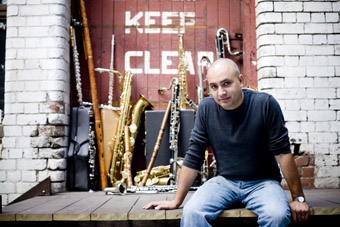 |
Adam Simmons photo Mark Chew |
Joined by local multi-instrumentalist Adam Simmons, this aesthetic becomes all the more palpable. Simmons contributions on the contra alto clarinet, soprano and tenor saxophones are often breathy, rough and always rich in character. His unique voice integrates remarkably well with the trio. As the players move beyond their traditional roles, their instruments blend in unusual ways, creating an intriguing sense of musical foreground and background. Pianist Laia Genc leans into the piano to play its strings, while bassist Sebastian Gramms uses his bow to produce a plethora of effects.
Leaving the realm of jazz completely, Simmons and Gramms engage in an improvised duet. Exploring a variety of effects, their interaction is based on the blending of complex and often very dense textures. There is an obvious rapport shared between these two that suggests a history of working together. Simmons and Gramms first met through an encounter at Music OMI, an international residency program in upstate New York. The purpose of this program is for musicians to learn more about their craft through playing and collaboration. There are no stylistic or technical agendas, but rather an interest in finding common ground on which musicians from different backgrounds can interact.
Simmons comes from a tradition of free jazz musicians such as Anthony Braxton, Albert Ayler and Roland Kirk, this influence felt not only in various sounds and techniques, but also as something that is inherent in their approach. He displays a deep fascination with the freedom and risks that come with improvised music. His passion for finding different ways to present this music has led him to become involved in Music OMI as both resident and mentor. He has since formed collaborations with groups such as Liaison Tonique, and has established himself within an international network of musicians from Europe and America.
Simmons also appears to have an interest in finding ways to connect with audiences unfamiliar with free jazz or avant-garde music. This is perhaps most apparent in his project the Adam Simmons Toy Band: an eight piece jazz ensemble with an added theatrical element. Players perform on a variety of toys, engaging the audience in a sense of play. Sophisticated in its phrases and harmonies, the Toy Band is a vehicle for Simmons compositional work. While this kind of composition might usually appeal more to a specialist audience, the theatricality of the toys sheds a light on the music, helping to broaden its appeal. In a typical performance, an audience will experience a generally chaotic atmosphere, with rubber chickens, bubbles, balloons and improvised solos along with ensemble playing of the highest calibre.
Simmons’ creativity and talent for collaboration make him one of the most in demand musicians on the Melbourne scene. His involvement with groups such as Embers, The Australian Art Orchestra, Bennett’s Lane Big Band, New Blood and Bucketrider (to name a few), testifies to his versatility as a performer. This is no more apparent than in his live shows which incorporate an arsenal of wind instruments and creative approaches to composition and improvisation. A recent CD release, simply titled Adam Simmons, demonstrates his work as a solo performer.
Opening with “Alak-ala”, the CD introduces the fujara—a large folk fipple flute, originating from Slovakia. Using a 7/8 groove with a quasi back-beat feel, the piece gradually moves through and blends overtones, exploiting the full colouristic effect of this instrument. In 5:27am, which follows, we hear short, fast melodic flurries on the piccolo. These fragments gradually evolve into longer phrases. Aside from some variation (a few staccato notes and a flutter tongue passage at the end) this is the basic compositional device from which the piece is constructed. At times it resembles a demented Ross Edwards’ work, its roughness and ambiguity in pitch aside.
The next composition moves into a darker space, created through the low tones of the contra alto clarinet. This piece, “Forbidden History”, is an exercise on the variety of colouristic effects possible on this instrument. Using only one note, Simmons explores and combines its overtones, mixing it with an occasional breath sound. Moving to the shakuhachi, Simmons performs “Tagging”, a work that moves between expansive gestures and abrupt interruptions. Exaggerating this instrument’s breathy character, he uses airy, slurping, coughing, wheezing and vocal sounds, almost to the point of parody. Godel’s Yodel is an exercise in register and note density for sopranino saxophone. Beginning with wild flurries of notes, the texture gradually becomes more sparse, until only single, disjointed notes remain. “Heaven is a Place” also employs a simple device, using only two notes, oscillating a major second apart. There is a constant rhythm throughout, created by Simmons’ finger moving up and down. The click of the key is heard throughout, although the tones themselves fade in and out with the breath.
Simmons’ is a unique voice in Melbourne’s musical landscape. He has an inquisitive approach, investigating all the sounds and characters his instruments can produce. There’s often a sense of humour and light-heartedness in his work that does not detract from, but only enhances its impact.
www.adamsimmons.com; Adam Simmons CD, Fat Rain label, FAT 006
Simon Charles is the Aphids-RealTime writer in residence, 2008/2009.
RealTime issue #94 Dec-Jan 2009 pg. 45
© Simon Charles; for permission to reproduce apply to [email protected]








 back
back